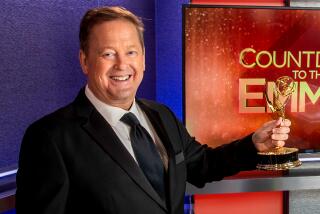‘Ruben Salazar’ filmmaker says L.A. Times review was ‘misleading’
- Share via
I write to address certain misleading points in Robert Lloyd’s review of my film, “Ruben Salazar: Man in the Middle” [“A Man Caught Between Cultures, April 29].
As its title clearly states, the film, shown April 29 on PBS and available on the network’s website, is about the life of Mr. Salazar and his place in the world. The film is not a sensational reveal about Salazar’s murder. Mr. Lloyd acknowledges this focus throughout most of his review: “[T]he film is [a] primer on a man whose life is little known.”
However, by the end of the review, Mr. Lloyd appears to have determined that, actually, the film should reveal — finally! — facts giving credence to conspiracy theories surrounding Mr. Salazar’s death. Claiming he perceived a promise of a big revelation, Mr. Lloyd is disappointed that there is none. No such promise was ever made, however, in any part of the film. Mr. Lloyd’s disappointment appears to be of his own making and seems out of place in a critical review.
In this vein, Mr. Lloyd dismisses the interview with the deputy who shot and killed Mr. Salazar. Outside of a coroner’s inquest, Deputy Tom Wilson was never publicly interviewed before this film. The deputy details his actions that day. He reveals insight into his character and his habit of reacting quickly. Finally, the deputy divulges his feelings about what he did. Thus, for the first time, the man who killed Ruben Salazar tells viewers that he did it, how he did it, why he did it and how he feels about having killed this innocent man. Yet Mr. Lloyd finds no substance there, disappointed yet again that some preconceived notion about how it all went down is not confirmed.
Next, he complains that suggestions of police spies in the crowds of protesters were uncorroborated. Yet the film shows an L.A. County attorney of the Office of Independent Review discussing her belief that there were undercover Sheriff’s Department, LAPD and intelligence officers in the crowds. Is Mr. Lloyd suggesting that the film should have corroborated a clearly expressed opinion from an expert in that field? It was an expert opinion, presented as such.
Finally, Mr. Lloyd dismisses the uncovering of hidden sheriffs’ files on Salazar; the victorious lawsuit that forced their opening to the filmmakers and public; the consequential triggering of a new investigation into Salazar’s death by the Office of Independent Review; and the resulting report brimming with new information. Mr. Lloyd essentially admits that, because the report did not reach the opposite conclusion, he finds no value in forcing government transparency and a new investigation with updated sensitivities based on new facts, photos and audio.
It seems Mr. Lloyd lost his way — at first understanding the story of Ruben Salazar’s life, but then suddenly disappointed that the reasons for his death were not more sensational. But this being a story of the life of Mr. Salazar, the disappointment should be that it was so senselessly cut short — Mr. Lloyd’s previous theories notwithstanding.
Phillip Rodriguez
Los Angeles
9/11 museum eloquently honors victims
I am neither a student of architecture nor have I visited the new 9/11 museum — only the 9/11 memorial that opened in 2011. I did however find Christopher Hawthorne’s review [“Saying Too Much,” May 26] to sound somewhat condescending.
He calls the museum an “overstuffed answer” to the minimalism of the memorial. On my visit last year, I did not find it asking that type of question. Instead, it was simply and eloquently honoring the victims and the families.
Mr. Hawthorne does acknowledge that the design is “profoundly emotional,” noting “they’ve made room for special pedestals holding boxes of tissues,” yet he ignores the fact that there are exits for guests who are overwhelmed at multiple points. He writes that the North Tower exhibits are “profoundly moving to a point of exhaustion.” Perhaps that’s the intent. People need the detail and intensity to remember. (I do agree with him that this is not where a gift shop has a place.)
He lastly notes the museum is lacking a place for one’s own thoughts. May I suggest a return to the memorial itself? The cascading waters and the names will give visitors a place for their thoughts, only now, much more vivid.
Stuart Fischman
Lake Forest
::
Huell Howser, a bear of a man
What a touching story on Huell Howser and of his donating his estate [“His Beaten Path,” May 24]. He was much loved by me and many, many more.
I met him twice, once at the Wisteria House festival in Sierra Madre, and once at a downtown gallery, where he’d been cornered by a few fans after his San Diego elephant story — all of us offering to drive the man to visit his elephant.
Huell was special. Growing up in England with a Daily Express comic strip of Rupert Bear, I loved Rupert. Huell and Rupert are alike: They are good guys. Enthusiastic, kind, do the right thing.
My brother used to say, “Rupert is too good. He’s never naughty.”
If all the men in the world were like Huell and Rupert Bear, the world would be a wonderful place.
Patricia Mace
Los Angeles
More to Read
The biggest entertainment stories
Get our big stories about Hollywood, film, television, music, arts, culture and more right in your inbox as soon as they publish.
You may occasionally receive promotional content from the Los Angeles Times.










